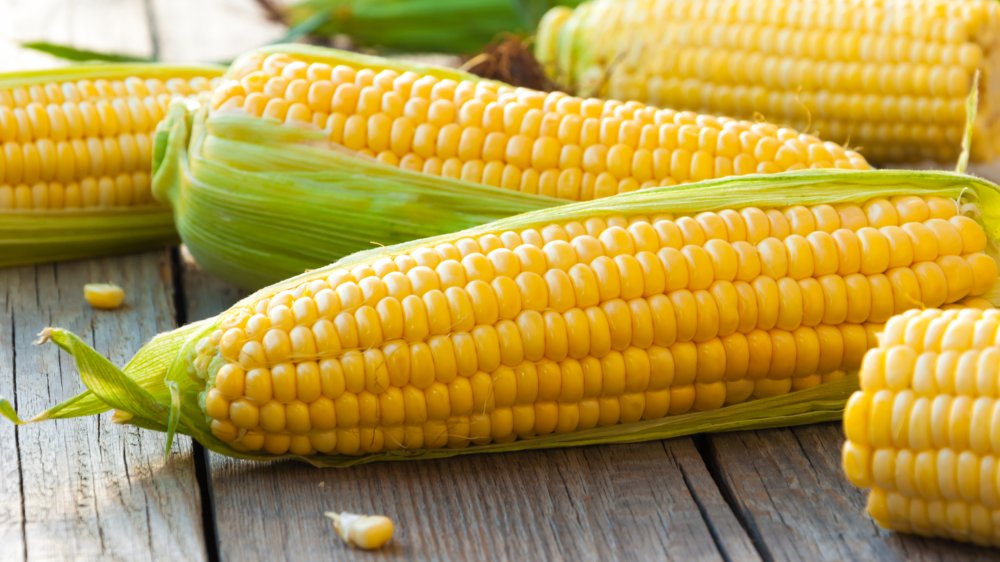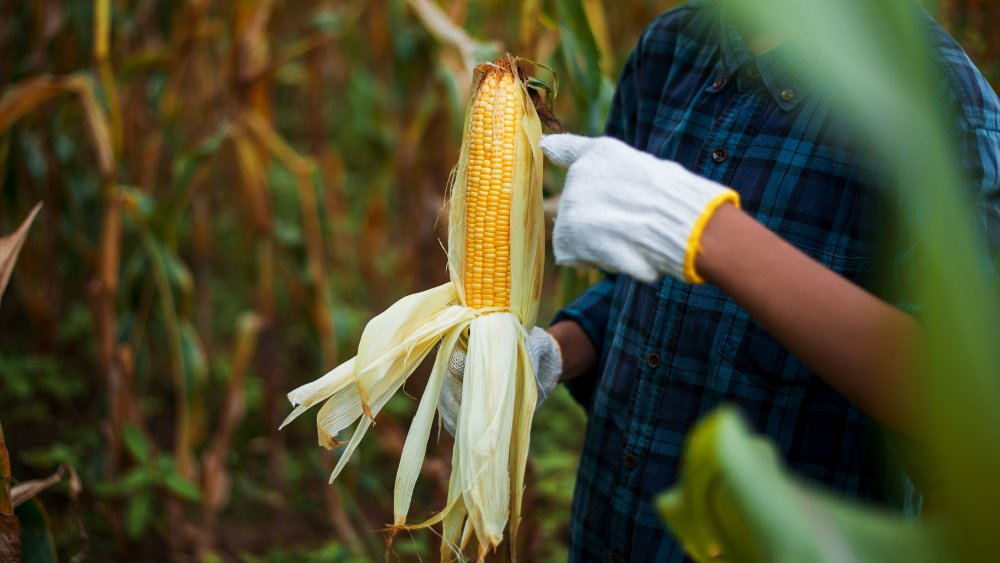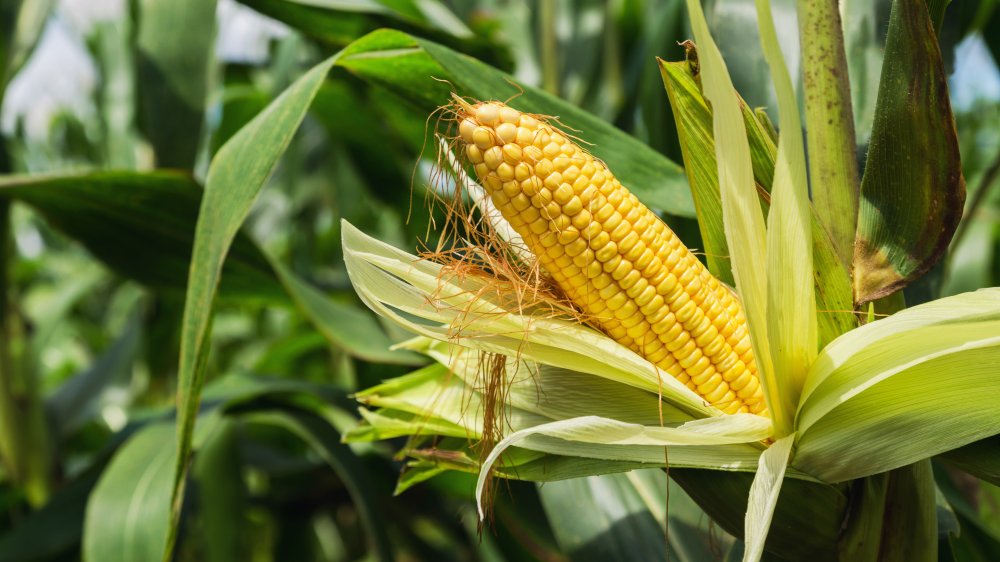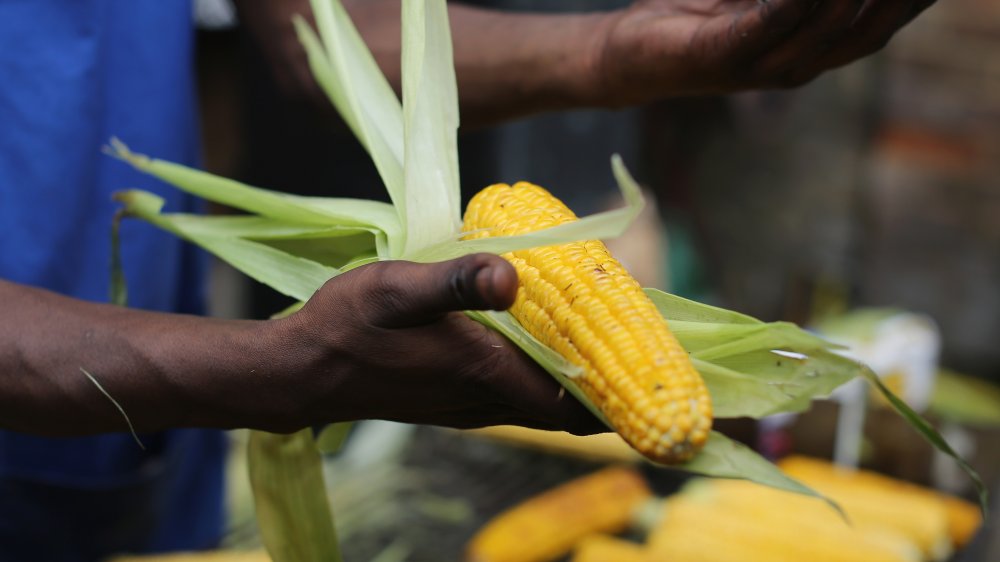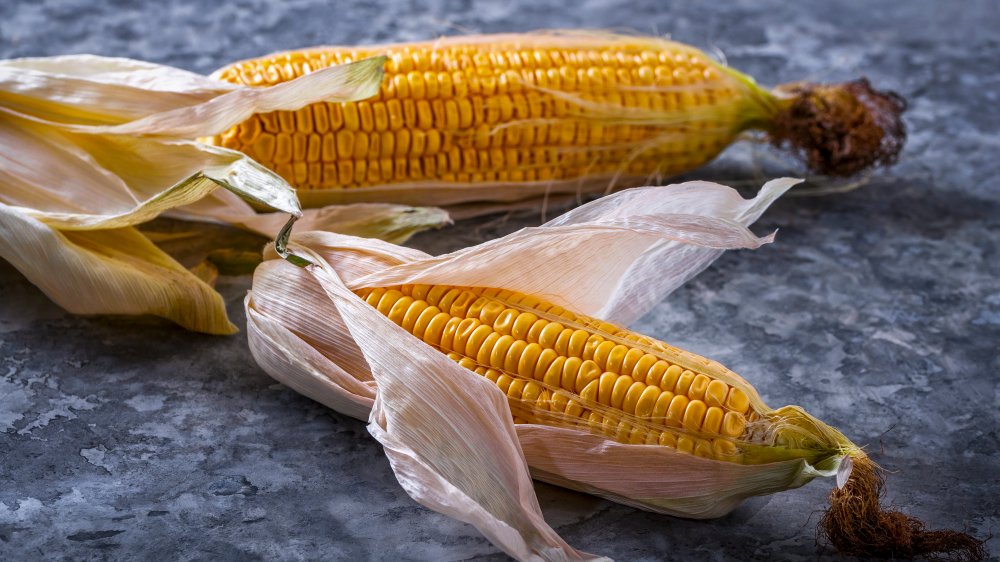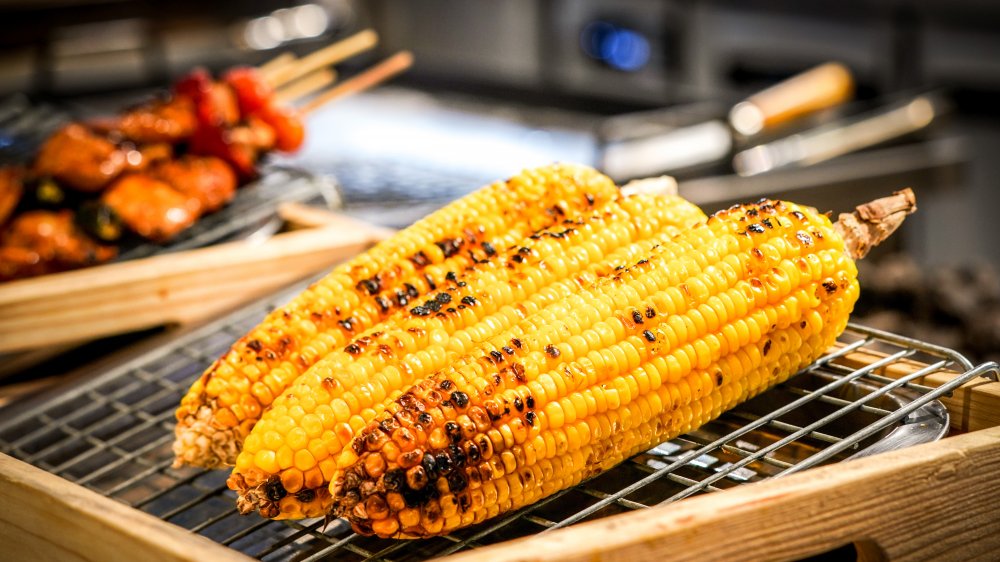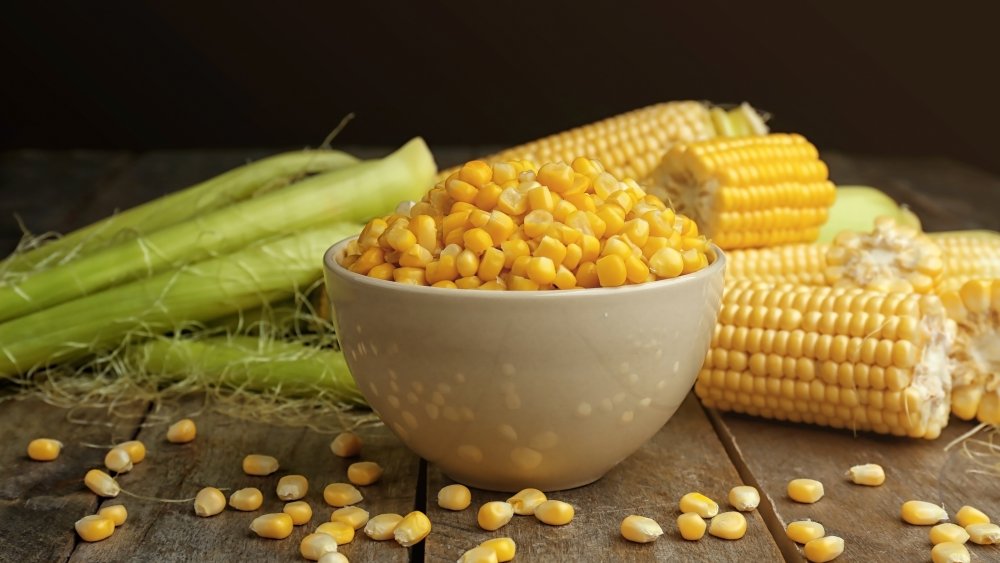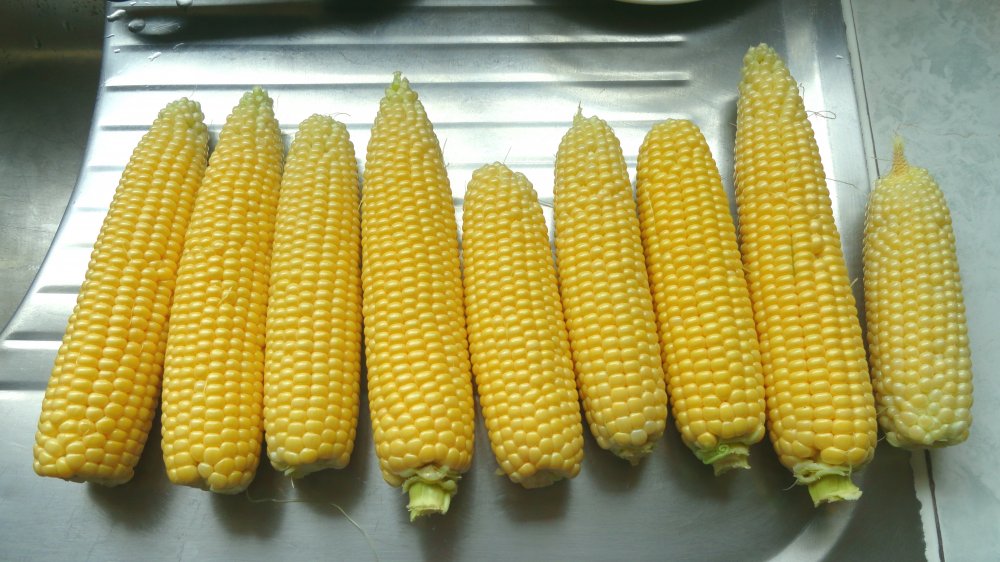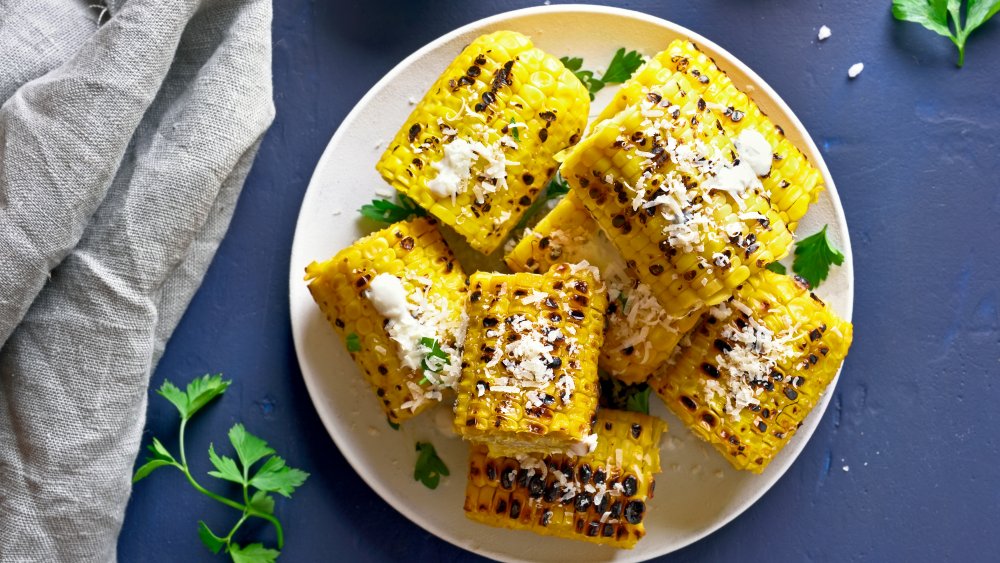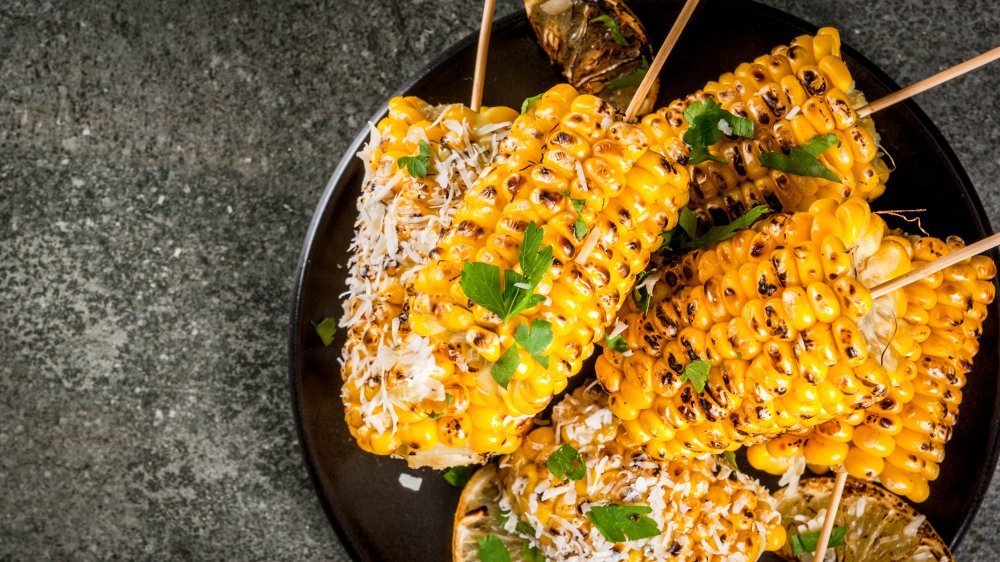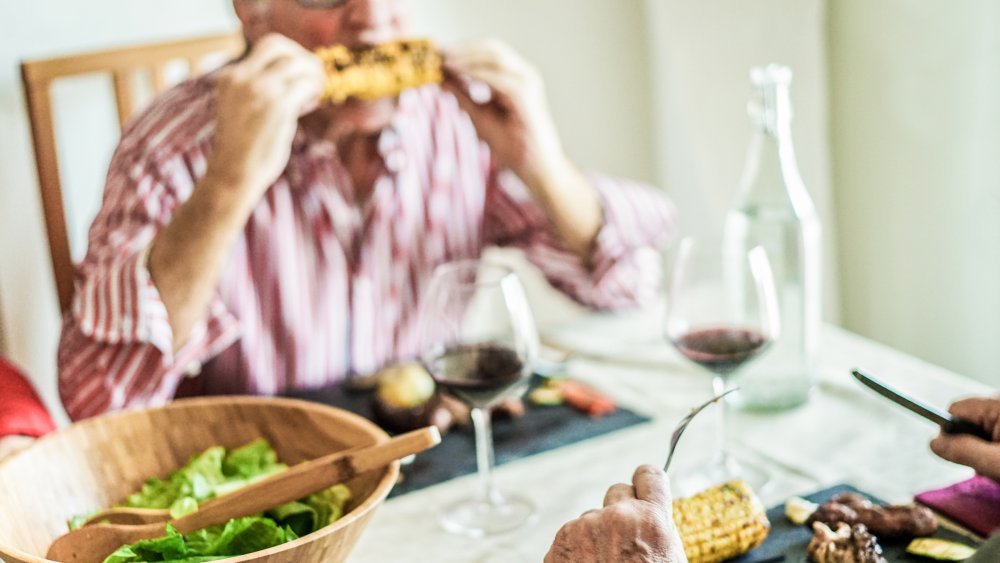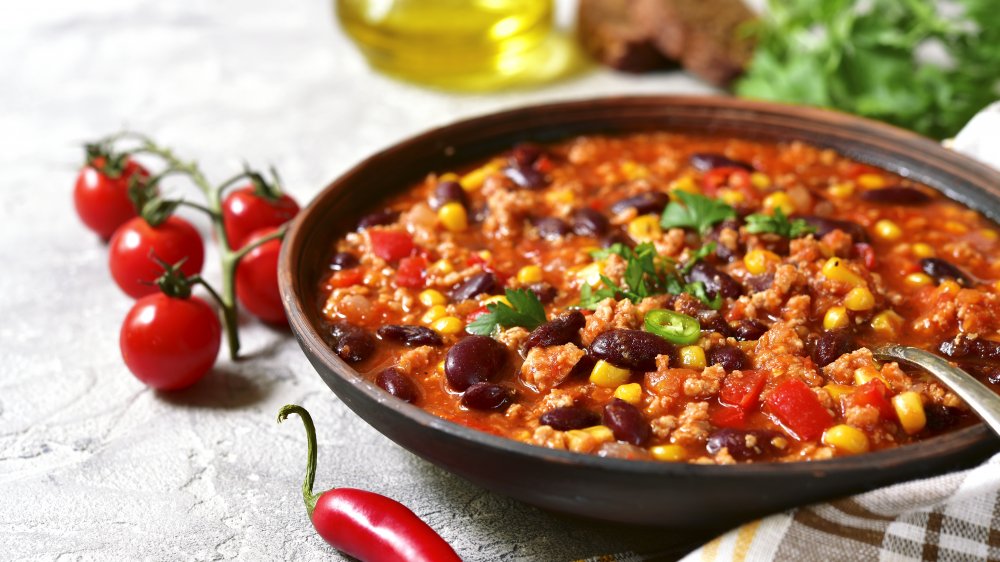Mistakes You're Making With Your Corn On The Cob
Summer is definitely the season for beautiful produce, from juicy watermelon and freshly picked strawberries to plump tomatoes. Summer is also prime time for corn, as its season kicks off in the beginning of May and runs all through summer — depending on where you're at, of course.
Corn is one of the most easily accessible fresh options for produce. Since it's grown in every state in the United States, it's pretty darn simple to find a few ears of good corn for dinner whether you're at the grocery store, the farmer's market, or a u-pick produce farm.
But once you pick up those gorgeous ears of corn and bring them home, what are you doing with them from there? Corn is incredibly versatile when it comes to cooking, but there are a few key tips and tricks to keep in mind, especially if you're preparing corn on the cob. It's one of the quintessential staples of summer, and you'll want to make sure you're serving it up in the most delicious way possible. These are the mistakes you're making with your corn on the cob.
Not choosing your corn on the cob correctly
The first step with any recipe is to start off with exceptional ingredients, and the same goes for making corn on the cob. After all, corn on the cob is a pretty simple dish, so you want to make sure you're kicking it off with the most flavorful produce.
To pick out the best corn, check the husks first. Choosing ears with a bright green husk, rather than a husk that's beginning to yellow or dry out, will produce the best results. The husk is what keeps the corn fresh, so if it's unwrapped slightly or turning a color other than green, it's generally best to skip those ears.
Checking the hair or tassels on the corn is helpful as well, as they can also tell you how fresh your corn is. If the tassel has started to decay, making it dry or black, you'll know that the corn is old. A fresh golden tassel will result in the best flavor for a juicy piece of corn on the cob.
Husking off your corn on the cob at the store
Have you ever walked through the produce section, spotted the incredible deal on corn on the cob, and walked away discouraged as you found all of the ears that were left husked and totally dried out? There's a reason some stores even put signs up asking customers not to open the husks of corn.
Corn grows inside a husk for a reason, providing the ideal home for moisture, and it's important to keep the husk intact for as long as possible.
If you choose to husk the cobs at the grocery store, you're not doing yourself any favors. As soon as the corn is husked and exposed, it's more open to heat, leading way for its starch to deteriorate faster and the texture of the kernels to begin to change. The husk can actually stay on during many of the cooking method you might choose for your corn on the cob, whether you're grilling, steaming, or microwaving. Once it's cooked, let it cool or use gloves to remove the husks to avoid burning your hands.
Not storing your corn on the cob properly
So, you've selected those beautiful, plump ears of corn at the store after strolling by a killer deal, but you're not planning to make your corn for a few days. No need to worry, but it is important to take a few steps to preserve your corn's freshness for the best possible corn on the cob.
It's important that you don't let your corn dry out, so removing the husks before you store them is definitely not the best way to go. The husks keep the existing moisture in the corn intact, ultimately keeping the corn fresher for longer.
According to Epicurious, it's best to wrap your ears of corn in plastic and store them in the fridge to avoid having them dry out before you're ready to make your corn on the cob. Or, if it will be quite a few days before your barbecue, wrap your corn and freeze it.
Boiling your corn on the cob (if you're counting as a healthy side)
There, we said it. Maybe one of the biggest mistakes you're making with your corn on the cob is the method you're choosing for cooking it. If you grew up in a household where boiled corn on the cob was the standard, it's time to branch out and consider why it may not be the best way to go.
Corn is chock-full of nutrients, including fiber, Vitamin C, magnesium, and folate which is incredibly helpful for good digestion and metabolism. But unfortunately, much of those nutrients that are water-soluble, such as folate and vitamin C, are totally lost when you boil corn.
As the ears are dunked in water and the starches begin to break down, some of those important nutrients seep out into the water, rather than remaining intact on the ear. So, while it may still be a delicious ear of corn for eating, any of the added benefits you may have been hoping to get from it are totally lost.
Not trying corn on the cob on the grill
While it's been said that boiling corn may not be the best method of cooking, it may be the only option for some kitchens. However, if there is an opportunity to grill your corn, it should definitely be taken. And if you haven't tried grilled corn yet, you're probably missing out.
First, grilling your corn allows for your husk to remain intact for longer. It's ideal to grill your corn with the husk on, as it helps to prevent the direct flame from interacting with the kernels. At the same time, the husk acts as a nice little blanket to shield the corn from getting up to temperature and cooking too fast.
Be sure to partially shuck the ears, removing the silk, before grilling and wrapping the husks back up around the ear. And while you're at it, consider adding butter or salt to the ear to really up the ante. The end result of a grilled ear of corn on the grill for ten minutes gives you a plump, juicy bite, rather than the potential of mushy corn from boiling.
Cooking your corn on the cob too long
Prepping a dish for the right amount of time is crucial for most recipes, as undercooking or overcooking can make all the difference in texture and flavor. And the same certainly goes for corn on the cob.
Cooking corn on the cob correctly is all about the starch in the corn, especially if you've chosen to boil your corn (despite the harm to its nutritional value). According to Cook's Illustrated, when corn heats up, the starch absorbs the water your corn is boiling in. At the same time, pectin found in corn begins to dissolve, ultimately making the corn soft and mushy. So, if you want to make sure you're ending up with juicy, plump cooked corn, keeping an eye on the timer and temp is crucial.
As you heat up your water, and the corn continues to boil, the starch starts to break down at 144 degrees. Meanwhile, the pectin that's dissolving does most of its work when it reaches 176 degrees. Keeping the temperature between 150 and 170 degrees is the perfect balance, and removing the corn from heat before it gets any hotter is ideal for a perfectly cooked ear of corn on the cob.
Running your cooked corn on the cob under cold water
As it's been established, corn can be a fickle vegetable. Sure, it seems like one of the easiest to cook and serve for summer, but it sure doesn't like changes in temperature. Just like adding in heat to the mix can change the texture of an ear of corn, drastically changing the temperature on it back to cold can make a difference as well.
If you've opted to boil your corn, or even if you grilled it, sometimes it's second nature to try to cool the corn down quickly so it can be served and enjoyed faster. After all, who wants to sit and stare at those steamy ears of corn, as you think about starting on dinner? Corn absorbs heat well thanks to its starch, and it can seem like an eternity before it cools down.
But waiting it out is definitely worth it, as introducing cold water to the hot ears will only cause temperature issues, ultimately resulting in a soggy product. Trust us, it's worth the wait for that first bite.
Putting too many toppings on your corn on the cob
Are you a corn purist, eating it right when it's cooked without adding anything else on top? Certainly, if you've selected the best possible corn, then the sweet, delicious flavors will shine through each ear. Or, there are those who love to add the classic bit of salt and butter to give your corn a bit more flavor, amplifying it in the simplest way.
Other great toppings for your corn on the cob include a dried herb medley, mixing together rosemary and thyme. Or, opt to add spicy flavors such as Tajin or harissa, or even try ricotta or goat cheese spread across the cob for a melty, creamy addition.
The goal here is to complement the corn's already-delicious fresh flavors, rather than masking it and using it as a vehicle for too many toppings. Keep the corn's flavor intact while upping its flavor profile in a simple way for the best possible experience.
Not trying it as Mexican street corn
When it comes to Mexican cuisine, may of the dishes found on the menu are portable and can be transported easily by hand, such as tamales, tacos, and burritos. And Mexican street corn is one of those items. According to Forbes, Mexico City is actually one of the top recognized cities when it comes to street food, and this summer staple definitely doesn't disappoint.
Mexican street corn, or elote, is made by grilling an ear of corn and topping it with butter, chili powder, mayonnaise, and cotija cheese. It's served on a stick, and it's the perfect snack when on the move. And if you haven't made it on your own, or some version thereof when prepping corn on the cob, you're sorely missing out.
Cook your corn, and then top it with the traditional fixings of butter and mayo, adjusting the chili powder level to your liking. Finish it off with a bit of cotija cheese to get a taste of this classic dish.
Not eating your corn on the cob correctly
We know, this can develop into a heated topic, whether you're enjoying corn on the cob among family or at a friend's barbecue.
Similar to enjoying a rack of ribs or a giant burrito, eating corn on the cob really isn't one of the most attractive activities, but it's so worth it. Because of the shape of an ear of corn, people typically opt to eat their corn "across," chomping left to right to eat all of the kernels before moving onto the next row, or they eat "around" as they chew in circles around the ear. There are two main schools of thought, but there is one clear winner when it comes to etiquette.
As it turns out, there is indeed a proper method for eating corn on the cob without grossing anyone out, all while maintaining your lovely table manners. Adding a bit of butter, salt, pepper, or whatever topping you choose to just a few rows of your corn at a time is the most mess-free way of doing it. And eating your cob a few rows at a time from left to right will avoid most of the mess, leaving you with a method to enjoy corn on the cob all summer long.
Not using your leftover corn on the cob
While, of course, corn on the cob can certainly stand on its own as a dish, there are so many other uses for corn you may be skipping once all is said and done. Did you make too much for family dinner? Don't let all of those perfectly prepped ears of corn go to waste.
Corn can easily be cut off of the cob to be used for any recipe that calls for canned or frozen corn. But this way, it will be that much fresher and will taste far better.
Leftover corn can be used to make a flavorful salsa or it can be added to quesadillas or tacos. Corn also makes a fantastic pizza or salad topping, adding juicy, fresh flavor. The whole leftover cob, sans the corn, can also be used as the ideal addition to a soup stock, adding incredible flavor along the way.
